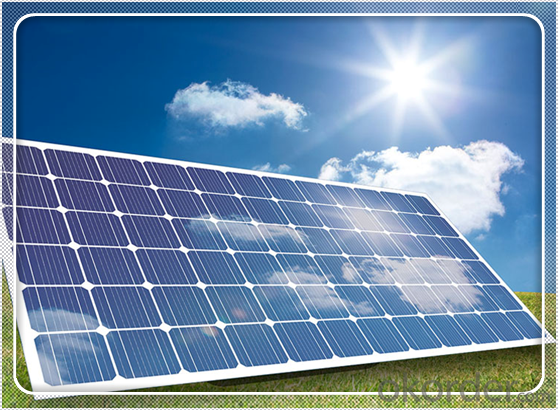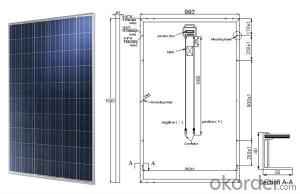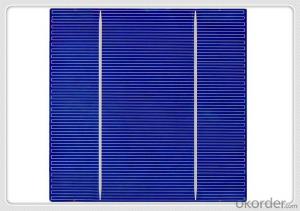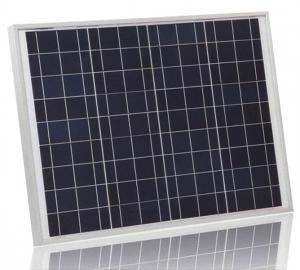50w Efficiency Photovoltaic Chinese Solar Panels for Sale 5-200w - Solar Panels New Orleans
- Loading Port:
- China main port
- Payment Terms:
- TT OR LC
- Min Order Qty:
- 10000 watt
- Supply Capability:
- 100000 watt/month
OKorder Service Pledge
OKorder Financial Service
You Might Also Like
Specification




Solar Module Introduction
Solar Module is the core part of solar PV power systems, also is the highest value part of it. The function of Solar Module is to convert the sun's radiation to electrical energy, or transfer it to battery and store in it, or to drive the load running.
The Product has been widely used in space and ground, it mainly used for power generation systems, charging systems, road lighting and traffic signs areas. It could offer a wide range of power and voltage, and with high conversion efficiency, and long service life.
Solar modules use light energy (photons) from the sun to generate electricity through the photovoltaic effect. The majority of modules use wafer-based crystalline silicon cells or thin-film cells based on cadmium telluride or silicon. The structural (load carrying) member of a module can either be the top layer or the back layer. Cells must also be protected from mechanical damage and moisture. Most solar modules are rigid, but semi-flexible ones are available, based on thin-film cells. These early solar modules were first used in space in 1958.
Electrical connections are made in series to achieve a desired output voltage and/or in parallel to provide a desired current capability. The conducting wires that take the current off the modules may contain silver, copper or other non-magnetic conductive transition metals. The cells must be connected electrically to one another and to the rest of the system. Externally, popular terrestrial usage photovoltaic modules use MC3 (older) or MC4 connectors to facilitate easy weatherproof connections to the rest of the system.
Secification
Model Type | |
Peak Power-Pmax(W) | 5-200W |
Open Circuit Voltage-Voc(V) | 44.2 |
Maximum Power Voltage-Vmp(V) | 36 |
Short Circuit Current-Isc(A) | 5.4 |
Maximum Power Current-Imp(A) | 5 |
Maximum System Voltage | 1000V DC |
Maximum Series Fuse Rating | 10A |
Power Tolerance | -1~+3% |
Temperature Coefficients of Pmax | -0.45%/℃ |
Temperature Coefficients of Voc | -0.348%/℃ |
Temperature Coefficients of Isc | 0.031%/℃ |
Nominal Operating Cell Temperature | 44.5±2℃ |
Standard Testing Condition(STC) | Irradiance:1000W/m²;Temperature:25℃;AM=1.5 |
Qualification Test Parameters | |
Operating Temperature | -40℃~+85℃ |
Storage Temperature | -40℃~+85℃ |
Pressure Bearing | ≥5400Pascal/m² |
Wind Bearing | ≥5400Pascal/m² |
Mechanical Characteristics | |
Cell Size | Mono 125*125mm±0.5 |
No.of Cells | 72pcs(6*12) |
Dimension | 1580*808*40mm |
Weight | 15.5Kg |
Glass | 3.2mm High Transmission,Low Iron |
Frame | Anodized Aluminum Alloy |
Junction Box | IP65Rated |
Internal Diodes | 3 Bypass Diodes |
Cable | 1*4.0mm² Length 900mm |
Images
Packing & Shipping:
We have rich experience on how to pack the panels to make sure the safety on shipment when it arrives at the destination.
The normal size is packed by 25pcs/ carton / pallet. Paper carton for FCL shipping and wood carton for LCL shipping.
Warranty:
For c-Si panel: 25years output warranty for no less than 80% of performance, 10 years output warranty for no less than 90% of performance. Free from material and workmanship defects within 5 years.
For a-Si panel: 20 years output warranty for no less than 80% of performance, 10 years output warranty for no less than 90% of performance. Free from material and workmanship defects within 2 years.
FAQ:
(1)What price for each watt?
It depends on the quantity, delivery date and payment terms.
(2)What is your size for each module? Can you tell me the Parameter of your module?
We have different series of panels in different output, both c-Si and a-Si. Please take the specification sheet for your reference.
(3)Can you provide the peripheral products of the solar panels, such as the battery, controller, and inverter? If so, can you tell me how do they match each other?
Actually we are only manufacturer of solar panels, but we could try to source them for you in China if you need. We could provide you an optimal system design to instruct you how to install.
(4)Do you have the CE, TUV, UL Certification?
We’ve already passed all the tests, and any certificate is available.
(5)Have you ever sold your products to companies in my country?
Of course, we have customers in all general PV markets, but I think we should expand our market share along with the market growth.
(6)When did your company set up? You are a new company, how can I believe your quality?
We entered into Solar PV industry in 2005, now we have several plants in manufacturing of a-Si and c-Si panels, and our capacity is 220MW per year. Till now we have already passed all the tests by authorized laboratories, e.g. TUV, VDE, UL.
(7)Can you help us install the module if we cooperate with you?
We haven’t entered into installation sector, but we have the plan in near future.
(8) How do you pack your products?
We have rich experience on how to pack the panels to make sure the safety on shipment when it arrives at the destination.
(9) Can you do OEM for us?
Yes, we can.
(10)Can we visit your factory?
Surely, I will arrange the trip basing on your business schedule.
- Q: What is the purpose of solar panels?
- The purpose of solar panels is to convert sunlight into usable electricity, providing a clean and renewable energy source for various applications such as powering homes, buildings, and even vehicles, while reducing dependence on fossil fuels and mitigating environmental impact.
- Q: they are pretty expensive. So does it save you money on electricity in the long run? How easy is it to connect solar panels to your house?
- Yes, solar panels can cost allot of money up front. They will eventually pay for themselves over time. Today it is pretty easy to install solar panels. They've made panels so easy that you can pretty much just have a technician hook them up to the electrical box outside your house you start saving money. Any electricity you generate over what you use...the utility company will PAY you! If you dig my response please like me on Facebook (link below). Thanks!
- Q: How do solar panels reduce carbon emissions?
- Solar panels reduce carbon emissions by converting sunlight into electricity without burning fossil fuels. When sunlight hits the solar panels, it triggers a process called the photovoltaic effect, which generates electrical energy. This renewable energy source eliminates the need for traditional power plants that rely on burning fossil fuels, such as coal or natural gas, which release carbon dioxide and other greenhouse gases into the atmosphere. By harnessing solar energy, solar panels enable a cleaner and more sustainable electricity generation, significantly reducing carbon emissions and mitigating the harmful impacts of climate change.
- Q: I am doing a project on solar energy at the moment and I was just wondering how.
- my theory is that when sunlight hits the panel it excites the electrons from the rays there by making them move more quckly and attract them to a source with less elctrons making the panel positiveli charge and the electron collector negatively charged thereby connecting the negatively charged particles to which ever body it wishes to donate it too thereby causing electric charges
- Q: How do solar panels affect the roof's lifespan?
- Solar panels can actually extend the lifespan of a roof. They act as a protective layer, shielding the roof from harsh weather conditions and reducing direct exposure to sunlight. This helps to prevent deterioration and can ultimately prolong the roof's lifespan.
- Q: Can solar panels be integrated into windows?
- Yes, solar panels can be integrated into windows. This innovative technology is called Building Integrated Photovoltaics (BIPV), where solar cells are incorporated into the glass panels of windows. BIPV allows for the generation of renewable energy while still maintaining the functionality and transparency of windows.
- Q: Can solar panels be used in areas with high levels of hurricanes?
- Yes, solar panels can be used in areas with high levels of hurricanes. However, it is crucial to ensure that the solar panel installation is designed and built to withstand strong winds and other extreme weather conditions. This can be achieved through proper engineering, using sturdy mounting systems, and adhering to local building codes and regulations.
- Q: okay so im lookin 4 an article which explains how practical, wokable, feasible solar panels are. only positive points please :) give me the link. PLZ HELP!!!!
- Solar Panels are practical because they provide electricity to your home directly avoiding the rates paid to the utility. They are pay themselves off in 5 years or less and supply an income stream in NJ for 5 years!
- Q: Can solar panels be used for street lighting?
- Yes, solar panels can be used for street lighting. Solar-powered street lights use photovoltaic panels to convert sunlight into electricity, which is then stored in batteries for use during the night. This renewable energy source helps to reduce electricity costs and carbon emissions associated with traditional street lighting systems.
- Q: Okay, me and my friends are going to fix up an old trailer that's out in the woods, we want something to be able to run small electric appliances off of, but it's to far to run power to. How can we make a good but cheap homemade solar panel that we could plug things into? The trailer is in more of a field so it gets plenty of sunlight! Thanks for any help! :)
- Did okorder / . Possibly this could immediately instruct each and every one!
Send your message to us
50w Efficiency Photovoltaic Chinese Solar Panels for Sale 5-200w - Solar Panels New Orleans
- Loading Port:
- China main port
- Payment Terms:
- TT OR LC
- Min Order Qty:
- 10000 watt
- Supply Capability:
- 100000 watt/month
OKorder Service Pledge
OKorder Financial Service
Similar products
Hot products
Hot Searches
Related keywords




























